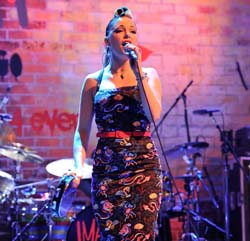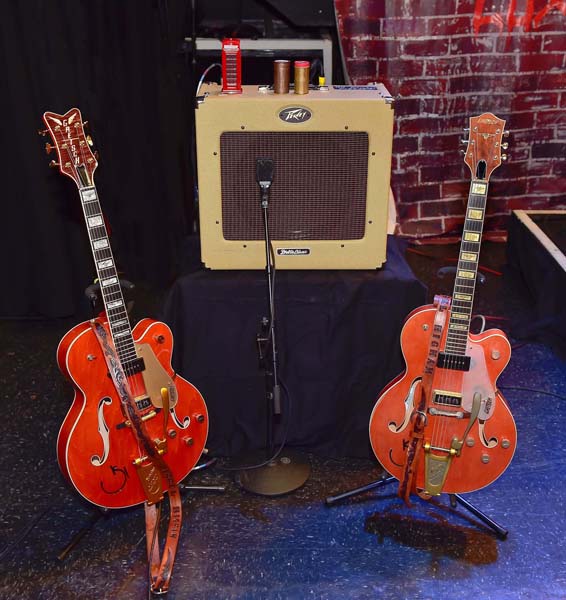
Basic & Effective
More likely to be found at front of house, McIntosh got the call from May’s camp three years ago and has worked monitors with her whenever she comes to the U.S.
“I kept telling them I’m not a monitor engineer, but they just won’t listen. I guess they just like me. It’s barrels of fun; they’re incredible,” says the veteran engineer who also has a long working relationship with Bobby Caldwell and has toured with John Tesh, Colin Hay, Ambrosia, and Jennifer Love Hewitt.
McIntosh prefers mixing on an Avid VENUE Profile or SC48 because he already has the show files saved and at the ready, easy to load and tweak. It’s a matter of keeping things simple. However, he adds that he’d never before had the opportunity to work on a DiGiCo board until the day we talked. “It’s a great console, and it may soon become my favorite if I keep getting them,” he notes.
May and her band, husband Darrel Higham on guitar, Dave Priseman on trumpet, flugelhorn, and guitar, Al Gare on electric and acoustic bass, and drummer Steve Rushton, are all on wedges. “They like stuff old school, even what they want in their mixes,” McIntosh explains. “There’s not much cross-mixing. They want to hear themselves, and the drummer is the only other one who gets Imelda. They’ve just got it down, working acoustically; so of course, I’m delighted.”
May is supplied with an inside and outside pair of wedges. In an approach devised by Gilligan, the inside set is delayed just a touch so that the output of all four reach her simultaneously. There’s no reverb or compression applied to the signal.
“It’s basic, but effective,” McIntosh says. “Imelda likes some power and sometimes that’s a little challenging, depending on which mic we’re using.” This time out the vocal mic choice was a Shure SM58, in place of the more usual Sennheiser e965.
“It’s much easier for me to dial up a 58,” he says. “I think Trevor likes the [e 965] because it’s a little more ‘hi-fi’ for him, but it’s a little more challenging for me.”
Nice Results
The number of lines from stage is typically around two dozen, plus or minus a few. “On this tour,” Gilligan points out, “Darrel’s not singing and he’s just got one mic in front of his amp. We haven’t got a slap pickup on the bass – all Al’s got is one line for his [acoustic bass] and one line for his electric, direct from the instrument.” The same goes for Higham’s guitar amp.

Horn player Priseman prefers a beyerdynamic M88 hypercardioid dynamic whenever one is available, preferring the punchy sound it delivers in his wedges. On the kit, Rushton’s cymbals are miked from below: “He plays the cymbals really nicely, so I mic him quite close, sometimes within eight to 12 inches of the cymbal,” Gilligan says. “If I’m really lucky and have a good digital desk, then I’ll put a bit of compression on them for when he whacks the hell out of them.”
He adds, “I’ve been getting a lot of success, believe it or not, putting an SM57 inside the kick drum. The 57 has a bit of extra bottom end; it’s really good for a little dynamic mic. Steve doesn’t have a big rock sound, so I put it reasonably close to the skin and then put the other mic, whether it be a 52 (Shure Beta 52A) or whatever, just inside the hole.
“If I’ve got a digital console I might put them both in place, and then on the out mic, start messing with the timing. You can get almost an out-of-phase sound. If I’m in these little venues, flipping the phase on one of them does the trick. You can get some nice results.”

The acoustic bass proved a challenge, largely due to the original instrument getting crushed in an unfortunate forklift incident early in the tour. After that, the quality of instrument each time out proved to be hit and miss. “Some of them sounded like planks of wood,” he notes. “The worst ones were the pickups—you get more body noise than bass.”
Traveling light makes for sound economic judgment on a tour of this scale, even when touring Europe, and both engineers met the challenges adapting on a show-to-show basis.
“I always try and find a desk that’s fully compact without racks of stuff, just a plug-and-go system,” concludes Gilligan, who typically works with Capital Sound in England. “If we can get it down to one truck instead of two, it saves us a massive amount of money. I’ve managed to find certain systems—like the Martin Audio MLA Mini—that don’t take up a lot of space and sound fantastic.
“It just makes more sense nowadays, because of the way the business is going. Everything’s getting cut back at certain levels, unless you’re massively successful.”
Based in Los Angeles, Steve Harvey is a long-time pro audio journalist and photographer.

